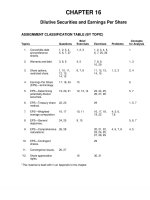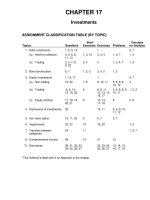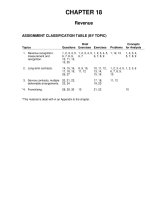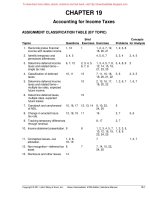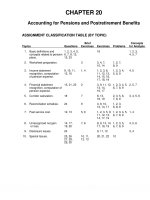Intermediate accounting IFRS 3rd ch07
Bạn đang xem bản rút gọn của tài liệu. Xem và tải ngay bản đầy đủ của tài liệu tại đây (3.05 MB, 104 trang )
Prepared by
Coby Harmon
University of California, Santa Barbara
Westmont College
7-1
CHAPTER 7
Cash and Receivables
LEARNING
LEARNINGOBJECTIVES
OBJECTIVES
After studying this chapter, you should be able to:
1.
2.
Indicate how to report cash and related items.
Define receivables and explain accounting issues
5.
Explain additional accounting issues related to
accounts and notes receivables.
Explain accounting issues related to valuation of
accounts receivable.
7-2
Explain accounting issues related to recognition and
valuation of notes receivable.
related to their recognition.
3.
4.
PREVIEW OF CHAPTER 7
Intermediate Accounting
IFRS 3rd Edition
Kieso ● Weygandt ● Warfield
7-3
LEARNING OBJECTIVE 1
Cash
Indicate how to report cash and related items.
Cash
Most liquid asset.
Standard medium of exchange.
Basis for measuring and accounting for all other items.
Current asset.
Examples: Coin, currency, available funds on deposit at the bank, money orders, certified checks,
cashier’s checks, personal checks, bank drafts and savings accounts.
7-4
LO 1
Cash
Reporting Cash
Cash Equivalents
Short-term, highly liquid investments that are both
a)
readily convertible to cash, and
b)
so near their maturity that they present insignificant risk of changes in value.
Examples: Government bonds, commercial paper, and money market funds
7-5
LO 1
Reporting
ReportingCash
Cash
Restricted Cash
Companies segregate restricted cash from “regular” cash.
Examples, restricted for:
(1) plant expansion, (2) retirement of long-term debt, and
(3) compensating balances.
ILLUSTRATION 7.2
Disclosure of Restricted Cash
7-6
LO 1
Reporting
ReportingCash
Cash
Bank Overdrafts
Company writes a check for more than the amount in its cash account.
Generally reported as a current liability.
Included as a component of cash if such overdrafts are repayable on demand and are an integral
part of a company’s cash management (such as the common practice of establishing off setting
arrangements against other accounts at the same bank).
7-7
LO 1
ILLUSTRATION 7.2
Classification of Cash-Related Items
7-8
LO 1
LEARNING OBJECTIVE 2
Receivables
Receivables
Define receivables and explain accounting issues related to their
recognition.
Receivables - Claims held against customers and others for money, goods, or services.
Oral promises of the purchaser to pay for goods
and services sold.
Accounts
AccountsReceivable
Receivable
Written promises to pay a certain sum of money
on a specified future date.
Notes
Notes
Receivable
Receivable
7-9
LO 2
Receivables
Non-Trade Receivables
1.
Advances to officers and employees.
2.
Advances to subsidiaries.
3.
Deposits paid to cover potential damages or losses.
4.
Deposits paid as a guarantee of performance or payment.
5.
Dividends and interest receivable.
6.
Claims against: Insurance companies for casualties sustained; defendants under suit; governmental bodies for
tax refunds; common carriers for damaged or lost goods; creditors for returned, damaged, or lost goods;
customers for returnable items (crates, containers, etc.).
7-10
LO 2
Non-Trade
Non-Trade
Receivables
Receivables
ILLUSTRATION 7.3
Receivables Statement of Financial Position Sheet Presentations
7-11
LO 2
Recognition
Recognitionof
ofAccounts
AccountsReceivables
Receivables
Accounts receivable generally arise as part of a revenue arrangement.
The revenue recognition principle indicates that a company should recognize revenue
when it satisfies its performance obligation by transferring the good or service to the
customer.
7-12
LO 2
Recognition
Recognitionof
ofAccounts
AccountsReceivables
Receivables
For example, if Lululemon Athletica, Inc. (CAN) sells a yoga outfit to Jennifer Burian for $100 on
account, the yoga outfit is transferred when Jennifer obtains control of this outfit. When this change in
control occurs, Lululemon should recognize an account receivable and sales revenue. Lululemon
makes the following entry:
Accounts Receivable
Sales Revenue
7-13
100
100
LO 2
Recognition
Recognitionof
ofAccounts
AccountsReceivables
Receivables
Some key indicators that Lululemon has transferred and that Jennifer has obtained control of the yoga
outfit.
7-14
1.
Lululemon has the right to payment from the customer.
2.
Lululemon has passed legal title to the customer.
3.
Lululemon has transferred physical possession of the goods.
4.
Lululemon no longer has significant risks and rewards of ownership of the goods.
5.
Jennifer has accepted the asset.
LO 2
Receivables
Measurement of the Transaction Price
The transaction price is the amount of consideration that a company expects to receive from a
customer in exchange for transferring goods or services.
Variable Consideration
In some cases, the price of a good or service is dependent on future events. These future events often
include such items as discounts, returns and allowances, rebates, and performance bonuses.
7-15
LO 2
Variable
VariableConsideration
Consideration
Trade Discounts
Use to:
7-16
Avoid frequent changes in catalogs.
10 % Discount for
new Retail Store
Alter prices for different quantities purchased.
Customers
Hide the true invoice price from competitors.
LO 2
Variable Consideration
Cash Discounts (Sales Discounts)
Offered to induce prompt payment.
Terms such as 2/10, n/30, 2/10, E.O.M., or
net 30, E.O.M.
Gross Method vs. Net Method.
Payment terms are
2/10, n/30
7-17
LO 2
Cash
CashDiscounts
Discounts(Sales
(SalesDiscounts)
Discounts)
ILLUSTRATION 7.5
Entries under Gross and Net Methods
7-18
LO 2
Variable Consideration
Sales Returns and Allowances
Sales Returns and Allowances is a contra revenue account to Sales Revenue.
Allowance for Sales Returns and Allowances is a contra asset account to Accounts Receivable.
The use of both Sales Returns and Allowances, and Allowance for Sales Return and Allowances
accounts is helpful to identify potential problems associated with inferior merchandise,
inefficiencies in filling orders, or delivery or shipment mistakes.
7-19
LO 2
Sales
SalesReturns
Returnsand
andAllowances
Allowances
Illustration: Assume that Max Glass sells hurricane glass to Oliver Builders. As part of the sales agreement, Max
includes a provision that if Oliver is dissatisfied with the product, Max will grant an allowance on the sales price or
agree to take the product back.
On January 4, 2019, Max sells $5,000 of hurricane glass to Oliver on account. Max records the sale on account as
follows.
Accounts Receivable
Sales Revenue
7-20
5,000
5,000
LO 2
Sales
SalesReturns
Returnsand
andAllowances
Allowances
Illustration: Assume that Max Glass sells hurricane glass to Oliver Builders. As part of the sales agreement, Max
includes a provision that if Oliver is dissatisfied with the product, Max will grant an allowance on the sales price or
agree to take the product back.
On January 16, 2019, Max grants an allowance of $300 to Oliver because some of the hurricane glass is defective.
The entry to record this transaction is as follows.
Sales Returns and Allowances
Accounts Receivable
7-21
300
300
LO 2
Sales Returns and Allowances
On January 31, 2019, before preparing financial statements, Max estimates that an additional $100 in sales
returns and allowances will result from the sale to Oliver on January 4, 2019. An adjusting entry to record this
additional allowance is as follows.
Sales Returns and Allowances
100
Allowance for Sales Returns and Allowances
7-22
100
LO 2
Variable Consideration
Time Value of Money
Theoretically, any revenue after the period of sale is interest revenue.
Companies ignore interest revenue related to accounts receivable because the amount of the discount
is not usually material in relation to the net income for the period.
The profession specifically excludes from present value considerations “receivables arising from
transactions with customers in the normal course of business which are due in customary trade terms
not exceeding approximately one year.”
7-23
LO 2
Accounts Receivable
How are these accounts presented on the Statement of Financial Position?
Allowance for
Doubtful Accounts
Accounts Receivable
7-24
Beg.
500
25
Beg.
End.
500
25
End.
LO 2
Accounts Receivable
7-25
LO 2





